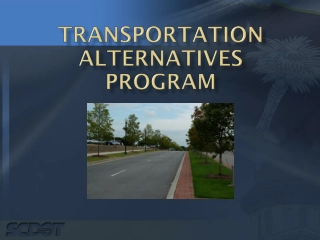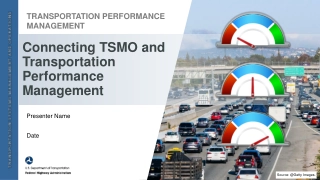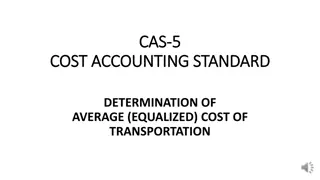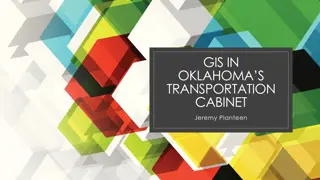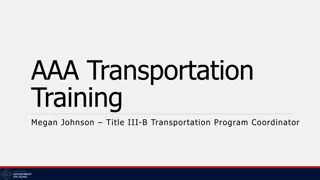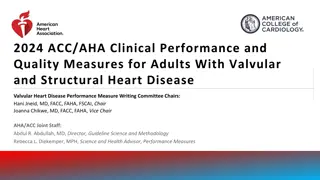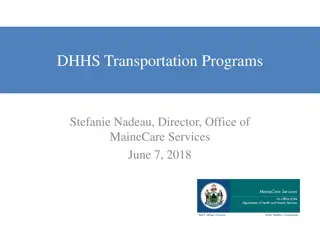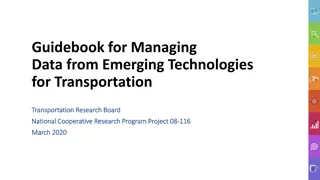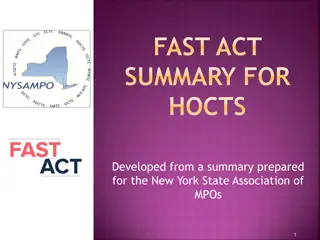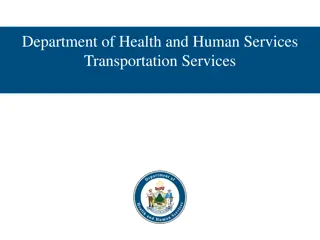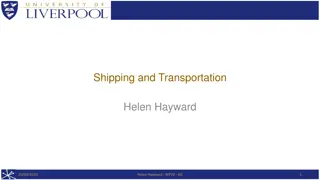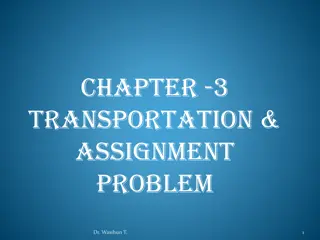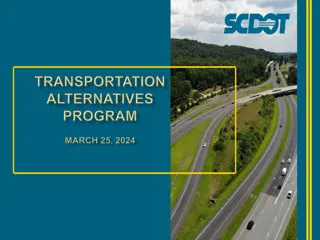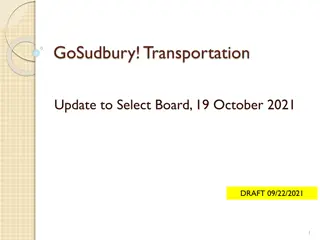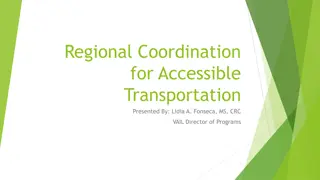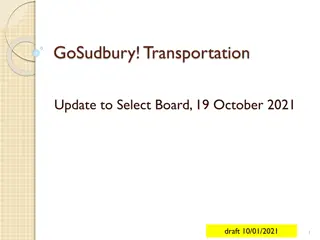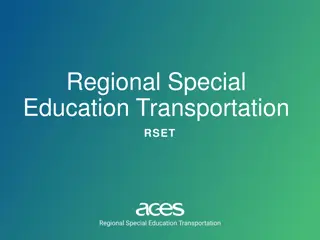Transportation Performance Measures and Data Integration
This study delves into the current practices and challenges of developing planning performance measures in the transportation sector. It focuses on integrating diverse data sources to create new performance metrics beyond traditional factors like user costs, travel time, safety, and emissions. The research aims to provide specific guidance in data integration methods and nontraditional performance measures, addressing data gaps and organizational challenges to enhance transportation efficiency.
Download Presentation

Please find below an Image/Link to download the presentation.
The content on the website is provided AS IS for your information and personal use only. It may not be sold, licensed, or shared on other websites without obtaining consent from the author.If you encounter any issues during the download, it is possible that the publisher has removed the file from their server.
You are allowed to download the files provided on this website for personal or commercial use, subject to the condition that they are used lawfully. All files are the property of their respective owners.
The content on the website is provided AS IS for your information and personal use only. It may not be sold, licensed, or shared on other websites without obtaining consent from the author.
E N D
Presentation Transcript
Acknowledgements This study was conducted for the AASHTO Standing Committee on Planning with funding provided through the National Cooperative Highway Research Program (NCHRP) Project 08-36, Research for the AASHTO Standing Committee on Planning. The NCHRP is supported by annual voluntary contributions from the state Departments of Transportation. Project 08-36 is intended to fund quick response studies on behalf of the Standing Committee on Planning. The report was prepared by Richard Margiotta of Cambridge Systematics with assistance from Bill Eisele of the Texas Transportation Institute. The work was guided by a technical working group that included the following: Marc S. Birnbaum, California DOT; Dr. Sundar Damodaran, Ontario Ministry of Transportation; James L. Hubbell, Mid-America Regional Council; Jessie X. Jones, Arkansas SHTD; Praveen Pasumarthy, Cambridge Systematics; Elizabeth Robbins, Washington State DOT; Marc D. Williams, Texas DOT; and Dr. Matthew Hardy, AASHTO (Liaison). The project was managed by Larry Goldstein, NCHRP Senior Program Officer. Disclaimer The opinions and conclusions expressed or implied are those of the research agency that performed the research and are not necessarily those of the Transportation Research Board or its sponsoring agencies. This report has not been reviewed or accepted by the Transportation Research Board Executive Committee or the Governing Board of the National Research Council. 2
Project Purpose Compile current practices for developing planning performance measures in terms of: Data integration methods Nontraditional performance measures Beyond user costs, travel time, safety, emissions Develop a research plan for developing specific guidance in these two areas Four Research Needs Statements Prepared 3
Literature Review: Findings Transportation agencies are integrating a variety of data to form new types of performance measures for assessing the effectiveness of projects and programs Transportation-related data sources, as well as the geospatial, ecological, built environment, cultural and social data sources, are of high relevance to meeting current and future transportation needs 4
Literature Review: Data Gaps Insufficient data samples Poor quality or biased data Incompatible data sources Inconsistencies across the existing public and commercial databases Lack of centralized data storage Organizational challenges Outdated data collection methods and data delivery practices Lack of skilled data analysts and experts Integration tools exist but require specialized skills Weak partnerships across various transportation agencies 5
Scan of Practice: Agencies Reviewed Metropolitan Transportation Commission (Bay Area) Metroplan (Little Rock, AR) Transportation Planning Organization (Chattanooga, TN) Southern California Association of Governments, CA Washington DOT Delaware Valley Regional Planning Commission, PA/NJ North Central Texas Council of Governments, TX (Dallas Area) Portland Metro (OR) Los Angeles Metro, CA 6
Scan of Practice: Mobility Much activity in measuring mobility/congestion Commercially available vehicle probe-based travel times are changing the game ability to monitor performance on the entire system Integration with other data volumes, incidents, roadway inventories, safety is gaining momentum Lack of data science skills hinders in-house development Commercial analysis packages are available Contractor-developed customized systems 7
Scan of Practice: Mobility (cont.) Mobility measurement is now shifting its perspective to how users experience the system for complete trips Enabled by the emergence of probe speed data that are greatly improving the accuracy and spatial coverage of performance measures for mobility analysis The next big thing in transportation data seems to be maturing origin-destination datasets, especially those that include origin-destination travel times 8
Scan of Practice: Mobility (cont.) The vision for the next generation of performance measures is the integration of: 1. Transportation system data 2. Origin-destination (O/D) data 3. Travel behavior data sources. Transportation system performance data from a variety of sources will continue to improve. In the future, improved traveler behavior data from crowd sources will provide data on personal travel and habits 9
Scan of Practice: Nontraditional Performance Measures Multimodal mobility performance measures --a single measure or small set of measures that can be used for the performance of multiple modes Current generation of multimodal measures are unique to each mode Data on movements at the person-level are needed to support true multimodal performance measurement Accessibility is just starting to be a major aspect of mobility performance Emerging data sources offer the prosect of measuring accessibility and trip performance, but technical challenges remain How a trip is defined? How long the dwell time is before a trip is terminated? What quality control has been applied to the data? 10
Scan of Practice: Nontraditional Performance Measures Health Data on the general health of individuals in a region are available but are controlled by non-transportation agencies Challenge is to build a collaborative effort with health mission agencies for data sharing Sustainability Definitions of what constitutes sustainability vary from environmental impacts to broader cultural and economic impacts. For some aspects of sustainability, new data collection is required to support potential measures, especially in the areas of ecosystem impacts, waste generation, and resource consumption. 11
Scan of Practice: Nontraditional Performance Measures Land Use and Economic Development Interaction of land use and economic development with transportation is becoming a topic of great interest Land use patterns (e.g. densification) seen as a way to reduce congestion Land use and economic activity change slowly over time, making many of these measures more appropriate for long-range planning efforts Economic equity and opportunity across socio-demographic groups being used a measure in a few places Transit investments sometimes spur gentrification improving economic opportunity does not necessarily maximize economic output A compendium on nontraditional measures currently in use by agencies was compiled by the project. The compendium should be used as a starting point for the follow-on research. 12
Scan of Practice: Findings Agencies are expanding the set of performance measures used for project evaluations and areawide monitoring It is clear that the traditional set of measures focused on congestion, safety, and infrastructure condition are insufficient to meet the needs of agencies. Visions, goals, and objectives set by agencies are broadening to include areas such as social equity, sustainability, economic development, and livability performance measures to monitor progress in these areas are being developed and tested. In general, there is a recognition that transportation investments affect the overall quality of life in an area and must be viewed within that context, rather than narrowly focused on the first order impacts on users 13
Scan of Practice: Findings (cont.) Project-level measures/criteria are linked to agency performance goals, but quantitative measures and supporting data to track progress toward those goals is lacking or not well formed Developed primarily through the use of models or qualitative assessments during the project development process. Some agencies have plans to put monitoring systems in place, but none of them seem sophisticated enough to capture performance metrics such as equity (e.g., number of disadvantaged population or transit dependent population served per square-mile; number of households at risk of displacement) 14
Scan of Practice: Findings (cont.) Nontraditional measures used for project evaluation are most often imbedded within a multiple criteria ranking system GIS technologies are widely used to join data from disparate sources and to conduct spatial analyses Monitoring performance at a more global level is also required Trends in areawide performance show the effect of programs can be assessed and redirected However, areawide trends are affected by many factors, not just transportation investments E.g., congestion trends are highly influenced by demand changes, which are driven by external factors such as fuel price and general economic conditions. 15
CASE STUDY: USE OF NONTRADITIONAL MOBILITY PERFORMANCE MEASURES AND DATA INTEGRATION
Comparison of Two Emerging Performance Measures Total Peak Period Travel Time (TPPTT) Computed from VHT, VMT, and road mileage using vehicle probe data Urban Macroscopic Network Accessibility Indicator Weighted accessibility score: measured by the number of jobs reachable from an average point in the metro area by automobile 17
Comparison of Two Emerging Performance Measures (cont.) TPPTT Rank 3 6 24 35 6 6 18 3 18 30 Urban Accessibility Rank 28 9 4 8 19 1 12 3 14 15 Urban Area Atlanta, GA Boston, MA Chicago, IL Dallas, TX Detroit, MI Los Angeles, CA Miami, FL New York Metro Philadelphia, PA Phoenix, AZ 18
Research Needs Statements 1. Incorporating Origin-Destination Data into Mobility Performance Measurement Test the feasibility of using empirical origin-destination data to enhance current mobility performance measures and evaluate the feasibility of using new measures. Potential applications include: Input of O-D data to current measures such as travel time delay and various travel time indices Breakdown of measures by market segment and/or geographic area Development of new measures related specifically to O-D data Use of O-D data in refinement of demand and simulation models currently used in performance measure estimation 19
Research Needs Statements (cont.) 2. Development of Multi-Modal Measures for Mobility Performance Measurement advance the development of meaningful mobility and accessibility performance measures that incorporate and integrate multiple modes of transportation simultaneously Designed to help agencies to better identify transportation needs and evaluate the impact of proposed projects on all transportation users. Benefits will allow better assessment of transportation needs and impacts of different market segments, including transportation-disadvantaged groups 20
Research Needs Statements (cont.) 3. Development of Non-Traditional Performance Measures for Economic Accessibility Advance the development of meaningful economic accessibility measures Designed to help agencies to better conduct baseline assessments of current economic accessibility Identify transportation needs and evaluate Evaluate the impact of proposed projects on all transportation users by market segment 21
Research Needs Statements (cont.) 4. Development of Non-Traditional Performance Measures for Land Use and Environment Advance the development of meaningful land use and environmental measures that can be applied at the plan development level Develop guidance on what measures should be used and standard procedures for developing them Data requirements Scoring methods 22


